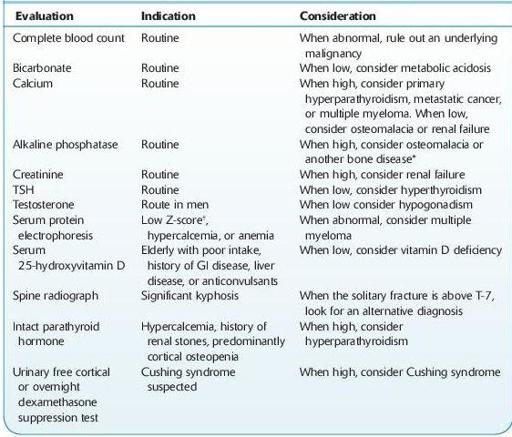Wallach's Interpretation of Diagnostic Tests: Pathways to Arriving at a Clinical Diagnosis (230 page)
Authors: Mary A. Williamson Mt(ascp) Phd,L. Michael Snyder Md

Osteoporosis is characterized by low bone mass, microarchitectural disruption, and increased skeletal fragility. A patient has osteoporosis if the BMD is diagnostic, or if spontaneous, nontraumatic fractures of the wrist, spine, or hip are present. Osteoporotic fractures (especially of the hip) are a significant cause of morbidity and mortality, particularly in the elderly. Osteoporosis is generally a disease found in women. Men may also be affected, particularly those with hypogonadism or those taking medications that increase the risk of osteoporosis. Patients with osteoporosis have normal bone composition, but too little bone. This is in contrast to patients with osteomalacia, in whom there is failure of normal mineralization of bone matrix.
Who Should Be Suspected?
The recommendation is to assess risk factors for fracture in all adults, especially postmenopausal women, men >60 years of age, and in any individual who experiences a fragility or low-trauma fracture
Risk factors:
1. Caucasian and Asian races
2. Women >55 years of age and men >65 years of age
3. Postmenopausal state or hypogonadism
4. Patients with a history of fragility fractures
5. Long-term glucocorticoid use
6. Acquired osteopenia secondary to disorders such as anorexia nervosa, exercise-associated amenorrhea, delayed puberty, cystic fibrosis
7. Drug use includes anticonvulsants, prolonged administration of heparin, excessive doses of thyroxine, and high doses of methotrexate
8. Sedentary lifestyle
9. Cigarette smoking and alcohol abuse
Laboratory Findings (Figure
6-15
; Table
6-9
)
Bone densitometry: Bone density measurements are used in conjunction with fracture risk assessment for osteoporosis screening. Multiple techniques have been developed for the measurement of bone mass, and usage depends mainly on local availability. Dual-energy x-ray absorptiometry (DXA) is the most widely used method. Because BMD varies between sites, evaluation at more than one site is recommended.
Laboratory evaluation in a patient with suspected osteoporosis is listed in Table
6-9
. It is also important to test for plasma albumin and 25-hydroxycholesterol levels.

Figure 6-15
Algorithm for the evaluation of a patient with suspected osteoporosis.
TABLE 6–9. Laboratory Evaluation of Patients with Osteoporosis

GI, gastrointestinal; TSH, thyroid-stimulating hormone.
*Alkaline phosphatase can be transiently elevated with fracture.
†
Bone mineral density is >2.5 standard deviations below the mean of age-matched controls.
Suggested Readings
Khan F, Sachs H, Pechet L, et al.
Guide to Diagnostic Testing
. Philadelphia, PA: Lippincott Williams & Wilkins; 2002.
Raisz LG. Pathogenesis of osteoporosis. In: Rose B, (ed).
UpToDate
, Waltham, MA: UpToDate, Inc.; 2009.
Raisz LG. Screening for osteoporosis. In: Rose B, (ed).
UpToDate
, Waltham, MA: UpToDate, Inc.; 2009.
Chapter
7
Genitourinary System Disorders
Charles R. Kiefer
Bladder Cancer
Prostate Cancer
Carcinoma of the Renal Pelvis and Ureter
Leukoplakia of the Renal Pelvis
Benign Prostatic Hyperplasia (BPH)
Calculi
Hematuria
Hemoglobinuria
Hyperoxalurias
Priapism
Retroperitoneal Fibrosis
Urinary Tract Infections
Tuberculosis, Renal
Epididymitis
Prostatitis
Overview
Testicular Disease
Disorders of Sperm Transport
Postvasectomy Status
Ovulatory Disorders
Hyperprolactinemia
This Chapter reorganizes the diseases and disorders of the genitourinary (GU) tracts and includes the latest information for the diagnosis of prostate and urinary tract diseases. Each entry is organized with a brief definition of the disorder and information regarding clinical presentation, laboratory findings, and limitations, if appropriate.
NEOPLASTIC DISEASES
BLADDER CANCER
Definition
Cancer arising in the urinary bladder is a carcinoma of urothelial (transitional cell) origin in the United States and Europe (90% of cases). Less frequently, urothelial carcinomas may originate in the renal pelvis, ureter, or urethra. In other parts of the world, bladder carcinomas of nonurothelial origin are more common.
Who Should Be Suspected?
